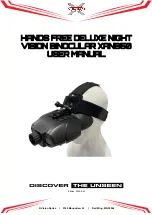
11
Minimum
Displays the lowest ADU pixel value for the immediate area.
Average
Displays the average ADU pixel value for the immediate area. This is useful to
see the general value of an area without letting a hot pixel throw off your reading.
Std Dev
Displays the standard deviation for the immediate area.
Global
Displays the
Std Dev., Average, Maximum, Minimum pixel values for the entire
image.
Star
Pay attention to the Half-Flux Diameter (
HFD) value when pointing the mouse
cursor at a star (
Figure 10), to determine the best focus. The smaller the HFD
value, the better the focus.
The following sections will describe more software features which you will
encounter during your imaging session, and later on when you are ready to
process your images.
4. Astronomical Imaging
Now that you have familiarized yourself with the basic functions of the camera
and software, you are ready to begin using the StarShoot G4 to capture images!
4.1. Focusing
Focusing the CCD camera is one of the most critical parts of imaging. It can be
challenging, but Camera Studio has some helpful features which will assist you
when focusing your G4. Before focusing, make sure your mount is polar aligned
and tracking. For best results, we recommend focusing on a star at least 30°
above the horizon (or higher). Follow these steps to achieve an accurate focus:
5. Find and center a moderately bright star through your finder scope. Try to
find a star around magnitude 4 or 5. If you are not using an optical finder
or just using your unaided eye, the star should look relatively faint. This is
important because brighter stars will easily over saturate the camera and
compromise the focus accuracy.
6. Center your telescope on the star using an eyepiece. Make sure the right
ascension (R.A.) tracking motor is engaged on your mount.
7. Replace the eyepiece with the G4.
8. Connect the G4 to your computer and open Camera Studio. In the
Camera
Control tab, click Connect.






































